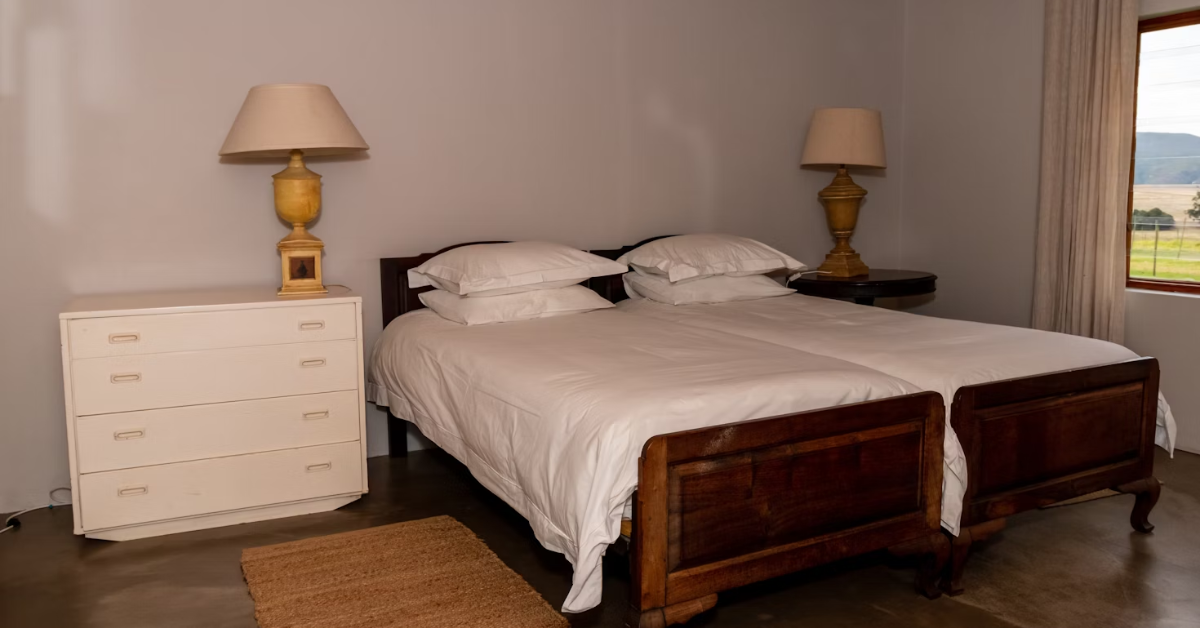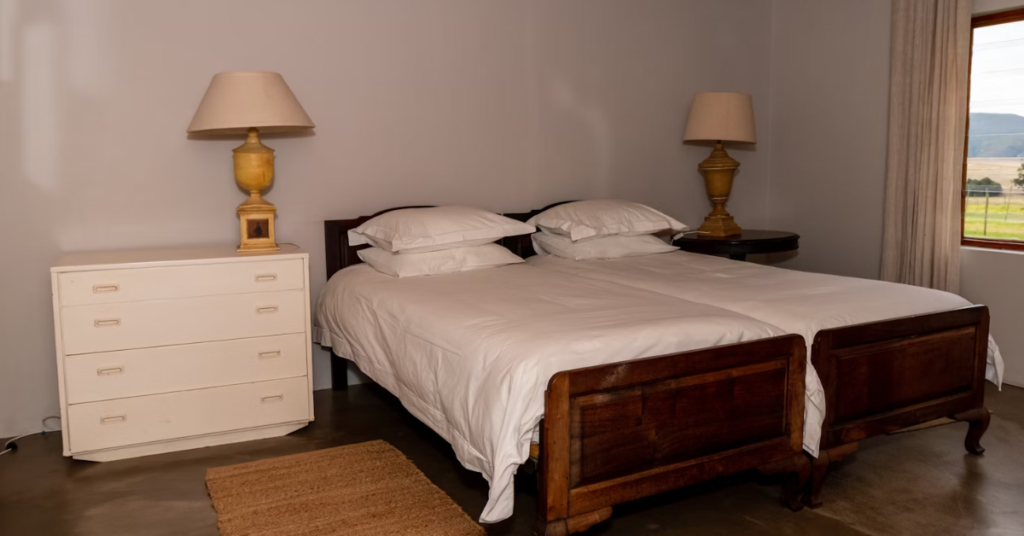
In a world filled with modern conveniences, the Amish’s traditional lifestyle sparks curiosity, especially about everyday choices like mattresses. Do they use regular beds like most people, or is there more to their sleeping arrangements?
Yes, Amish people do have mattresses. In keeping with their values of simplicity and quality, Amish mattresses are often distinct in their construction and material choice compared to mainstream mattresses.
To delve deeper into the unique world of Amish mattresses and discover how these handcrafted pieces reflect their culture and commitment to quality, read on for an in-depth exploration.
Amish Mattress Features
Amish mattresses, a blend of traditional craftsmanship and unexpected modern elements, stand out in their approach to comfort and durability.
High-End Comfort Layers
The construction of an Amish mattress goes beyond the ordinary. Each layer works harmoniously to provide contouring support, breathability, and pressure relief, ensuring a blend of comfort and longevity.
The added insulation is a bonus for colder nights, making these mattresses a blend of innovation and tradition.
Craftsmanship and Materials
Attention to detail is paramount in Amish mattress making. These mattresses are hand-tufted with natural materials like organic cotton and wool, providing superior comfort and reflecting the Amish commitment to quality and eco-friendliness.
Their craftsmanship, adhering to exacting standards, ensures a comfortable and lasting product.
Comparison with Conventional Mattresses
While both Amish and conventional mattresses serve the fundamental purpose of providing a comfortable sleeping surface, they differ significantly in their materials, construction, environmental impact, and availability.
These differences are reflected not only in their physical attributes but also in the values and lifestyles they represent.

Material and Construction
Amish mattresses distinguish themselves using natural, often organic materials like wool, cotton, and latex. This aspect contrasts with many conventional mattresses that rely heavily on synthetic materials and chemicals.
The handcrafted nature of Amish mattresses, with meticulous attention to detail, starkly contrasts the mass-produced methods commonly employed in standard mattress manufacturing.
Comfort and Durability
In terms of comfort, both Amish and conventional mattresses offer a range of options, including foam and innerspring. However, Amish mattresses’ high-end comfort layers and unique construction often enhance durability and longevity.
This point is a significant difference, as many conventional mattresses, especially those made with lower-quality materials, may not have the same lifespan.
Environmental Impact
The environmental footprint is another crucial area of comparison. The Amish mattresses’ eco-friendly materials and construction methods have a minor environmental impact than many conventional mattresses, which often incorporate more synthetic materials and chemical processes.
Price and Availability
In terms of availability and price, conventional mattresses are more accessible and often come with a wide range of price options.
Amish mattresses, handcrafted and made with high-quality materials, can be pricier and less readily available, typically requiring a visit to specific suppliers or direct orders from Amish communities.
Worried about the authenticity of your furniture? Find out more about Amish furniture and China-made furniture.
Amish Mattress Construction
The construction of Amish mattresses is a harmonious blend of tradition, quality, and sustainability. It reflects a way of life that values manual skill, respect for natural resources, and a commitment to producing long-lasting, high-quality products.
Handcrafted Quality
Each Amish mattress is a product of meticulous craftsmanship. Skilled artisans, reflecting a deep respect for their traditional methods, make these mattresses.
The process involves a careful selection of materials, with a focus on natural fibers like wool, cotton, and latex. The hand-tufting technique, a hallmark of their craftsmanship, ensures durability and comfort that often surpasses that of machine-made mattresses.
Natural Materials
In keeping with their ethos of simplicity and sustainability, Amish mattresses predominantly use natural materials. Natural latex, organic cotton, and wool are common, offering breathability and hypoallergenic properties.
These eco-friendly materials contribute to the mattress’s overall comfort and longevity, contrasting the synthetic fabrics and foams commonly used in mainstream production.
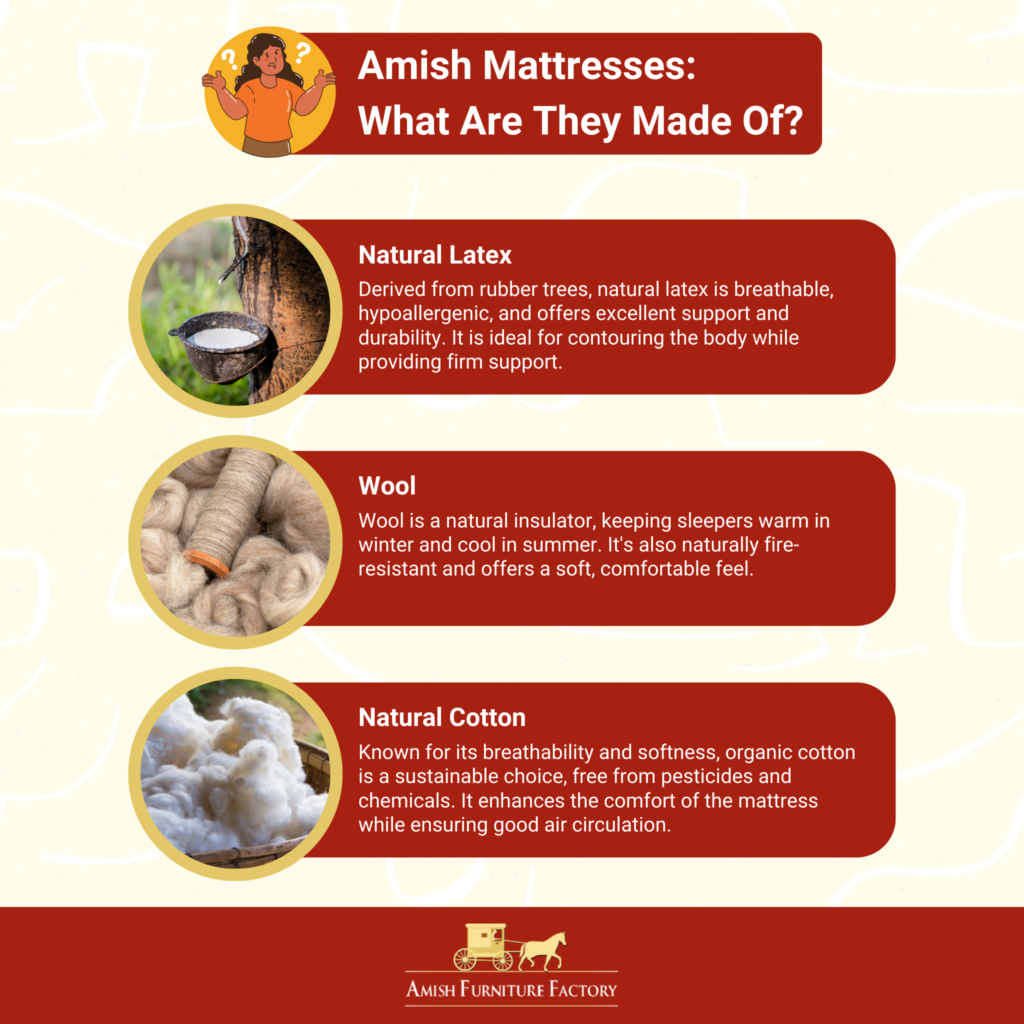
Eco-Friendly Approach
The Amish approach to mattress construction aligns with their broader values of environmental stewardship. By avoiding synthetic materials and chemical processes, they minimize the environmental impact of their products.
This sustainable approach extends to how they source materials, often locally, reducing the carbon footprint associated with transportation and production.
Attention to Detail
The level of attention to detail in Amish mattress construction is unparalleled. Every aspect is carefully considered and executed, from the stitching to the layering of materials.
This results in a comfortable, supportive, and aesthetically pleasing mattress, showcasing the beauty of handcrafted work.
If you’re interested, you might want to read more about the differences between a high and low footboard bed.
Types of Mattresses Used by Amish Families
While the types of mattresses used by Amish families may vary based on individual preferences and community norms, these mattresses typically embody the Amish principles of quality and comfort.
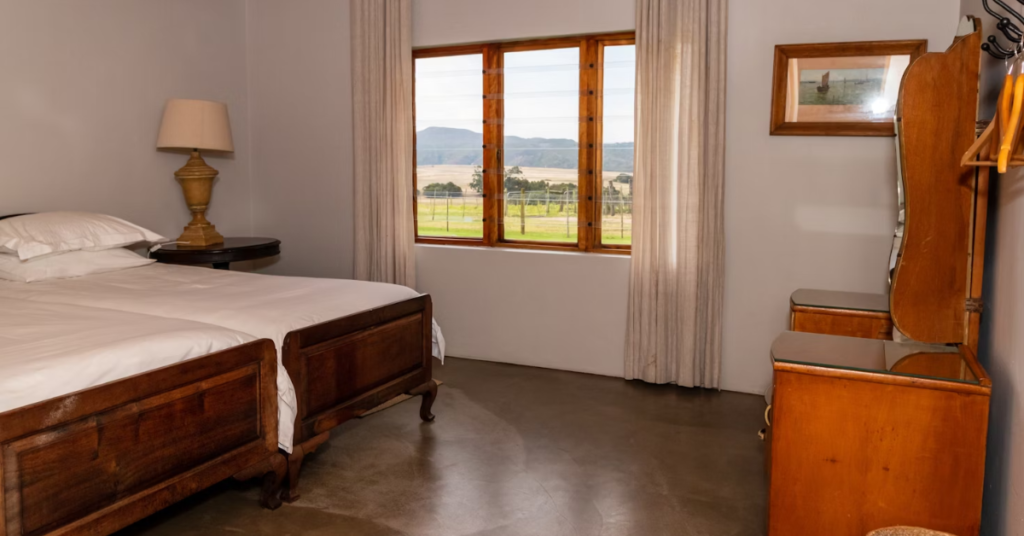
Traditional Handmade Mattresses
Many Amish families still use traditional handmade mattresses, often filled with straw, feathers, or cotton. These mattresses are known for their simplicity and align with the Amish commitment to using locally sourced, natural materials.
The craftsmanship of these mattresses is passed down through generations, highlighting their cultural importance.
Innerspring Mattresses
Innerspring mattresses are also commonly used among Amish families. These provide firmer support than traditional handmade ones and are often preferred for durability.
While still straightforward in design, they balance traditional mattress-making and modern sleeping comfort.
Foam Mattresses
Some Amish families have begun using foam mattresses made from natural latex, which provide higher comfort and support. These mattresses are especially valued for their pressure-relieving qualities and adaptability to different sleeping positions.
Foam mattresses the Amish use are typically more basic than commercial varieties, focusing on functionality and comfort rather than luxury features.
Wool-Filled Mattresses
Wool-filled mattresses are another type some Amish families favor, particularly for their natural temperature-regulating properties. Wool is an excellent insulator, keeping sleepers warm in winter and cool in summer.
Additionally, wool is naturally fire-resistant and hypoallergenic, making it a healthy and safe choice.
The Process of Mattress Making in Amish Communities
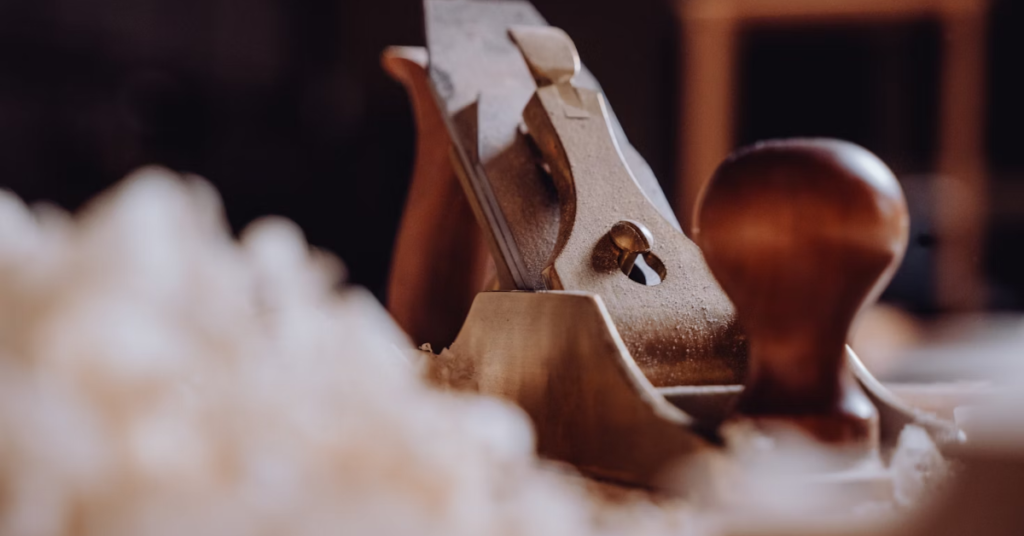
Just like furniture-making, the mattress-making process in Amish communities is a testament to their core values. Each mattress is a product and a piece of tradition, skillfully made to provide comfort and longevity.
Selection of Raw Materials
The process begins with the careful selection of raw materials. Amish artisans choose high-quality, natural materials like wool, cotton, latex, straw, and feathers.
These materials are often sourced locally or from trusted suppliers who adhere to sustainable practices. The choice of material not only determines the comfort and durability of the mattress but also its environmental impact.
Preparing the Materials
Once the materials are selected, they undergo preparation. Cotton may be carded and wool cleaned and fluffed to ensure they are free of impurities.
In the case of latex, it is processed into a foam. This preparation is crucial to ensure the final product is comfortable, hygienic, and long-lasting.
Assembling and Stitching the Mattress
The actual assembly of the mattress is a meticulous process. Layers of materials are carefully arranged, often starting with a sturdy base layer, followed by comfort layers like cotton or wool batting, and then topped with a layer of latex foam if used.
This layering technique is essential for achieving the desired balance of support and comfort.
Finishing Touches
Finally, the mattress is finished with a cover, typically made from durable, breathable materials like cotton. The cover is sewn on, often with a quilted design for added comfort and aesthetic appeal.
The finishing touches may include handles or vents, depending on the desired design and functionality.
Health Benefits of Amish Mattresses
Aside from providing a comfortable and supportive sleep experience, Amish mattresses also contribute positively to overall health. Their construction, focusing on natural, hypoallergenic materials and ergonomic design, offers benefits beyond mere comfort, potentially improving sleep quality and general well-being.
Support and Comfort
The design of Amish mattresses provides exceptional support and comfort. This is crucial for maintaining proper spinal alignment, which can alleviate common issues like back pain.
The customized layering in these mattresses ensures that the body is adequately supported at critical pressure points, promoting a healthier sleep posture and reducing the likelihood of discomfort.
Allergy-Friendly Materials
Amish mattresses offer a hypoallergenic advantage by using natural or organic materials, which are less likely to trigger allergic reactions compared to some synthetic fabrics used in conventional mattresses.
For those sensitive to allergens or who suffer from respiratory issues, an Amish mattress can be a beneficial choice, contributing to a cleaner, healthier sleeping environment.
Temperature Regulation
Materials like wool aid in temperature regulation, essential for a comfortable sleep. This feature mainly benefits those who sleep hot or live in warmer climates.
These mattresses help maintain a consistent, comfortable sleeping temperature by efficiently dispersing body heat.
Care & Maintenance of Amish Mattresses
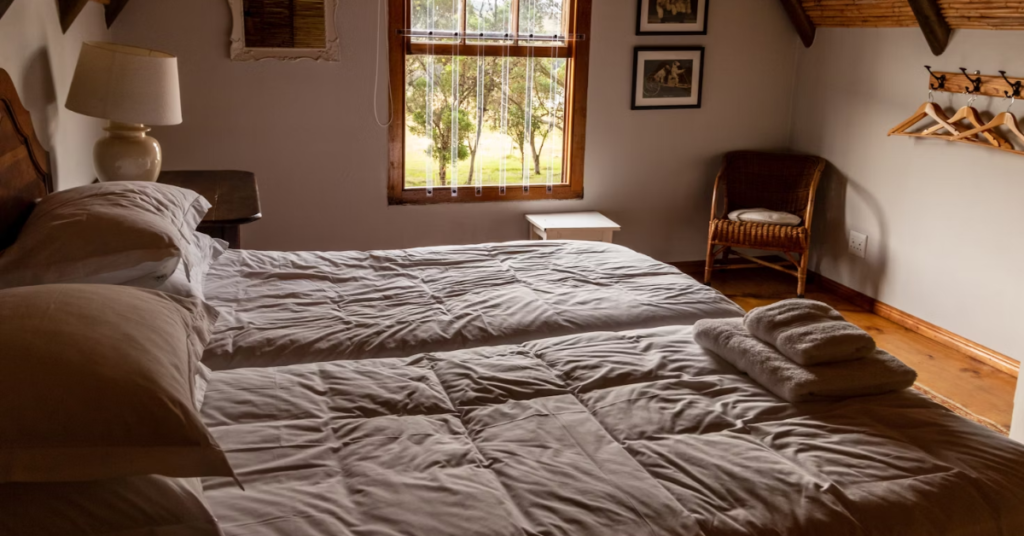
Proper care and maintenance enhance Amish mattresses’ comfort and performance and contribute to their longevity. These simple yet effective practices will ensure your mattress remains a comfortable and healthy sleeping surface for years.
Regular Rotation
Rotating the Amish mattress every three to six months is recommended to ensure even wear and prolong its lifespan. This practice helps distribute the wear evenly across the mattress, preventing sagging and maintaining its shape and comfort over time.
Cleaning and Spot Treatment
With natural materials like cotton and wool, following specific cleaning guidelines for Amish mattresses is essential.
For spot cleaning, it’s advisable to use mild soap and warm water, avoiding harsh chemicals that can damage the fibers. Gently dabbing the area rather than scrubbing helps preserve the integrity of the materials.
It’s also vital to ensure the mattress is completely dry before remaking the bed to prevent moisture buildup.
Use of Mattress Protectors
A mattress protector is a wise choice to safeguard against dirt, spills, and allergens. The protector should be breathable to maintain the natural properties of the mattress, such as air circulation and moisture-wicking.
Choosing a protector that complements your Amish mattress, whether foam, innerspring, or hybrid, is also advisable.
You might be interested in exploring if Amish people also have mirrors.
Amish Mattresses: A Journey into Comfort and Tradition
Delving into the realm of Amish mattresses reveals a unique harmony of tradition and modern practicality. These handcrafted pieces, rooted in Amish values of simplicity and nature, offer a comforting blend of healthful benefits and environmental mindfulness.
Reflecting a lifestyle deeply connected to natural rhythms, Amish mattresses are a testament to the enduring virtues of simplicity and sustainable living in our fast-paced, modern world.
